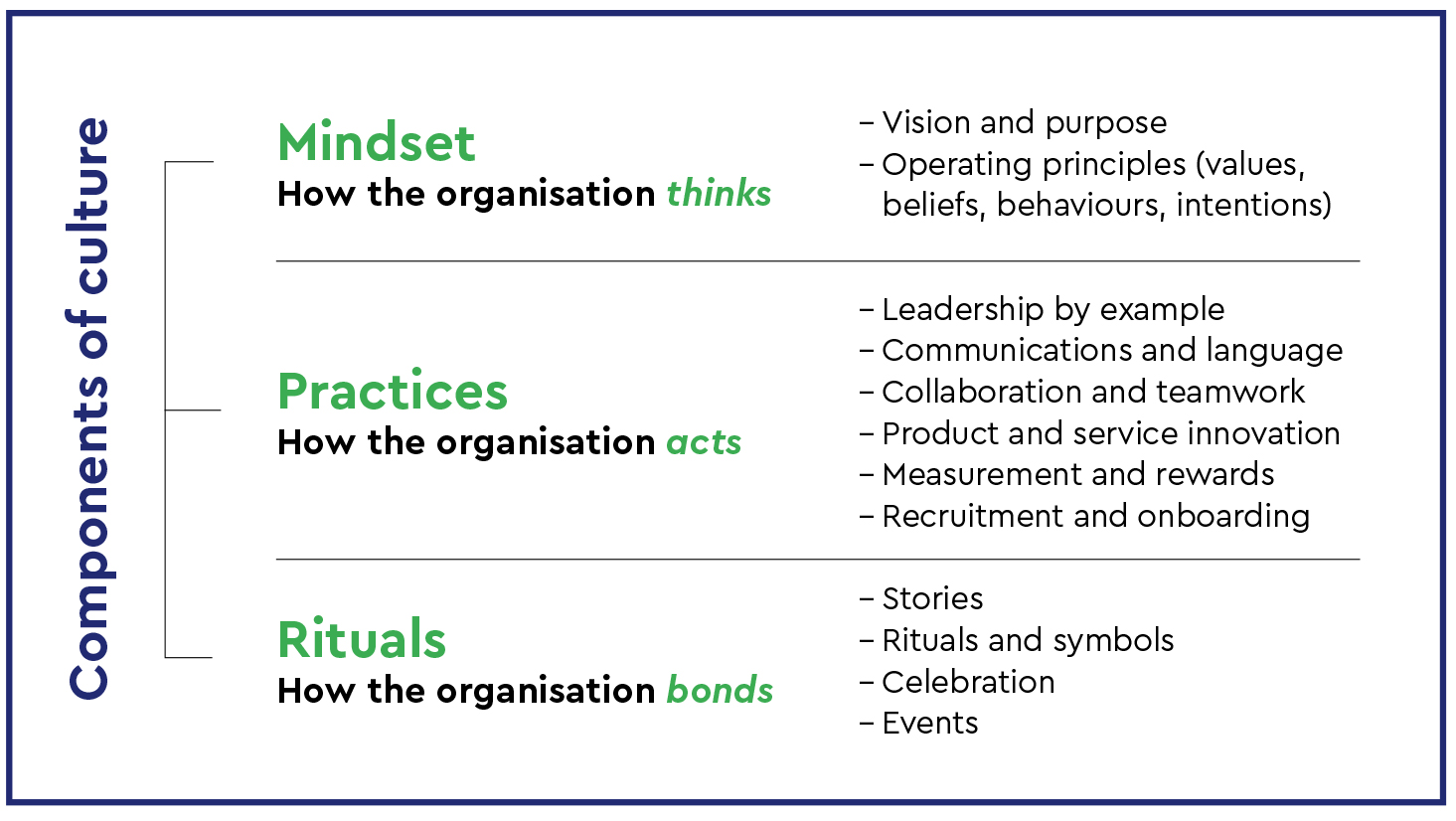
Putting the C in success
For fast-growing unicorn companies, culture is a critical driver of success, not just a people issue
"Culture eats strategy for breakfast."
When Peter Drucker famously made this statement, he wasn’t trying to undermine the importance of strategy. Instead, he was arguing that a strong culture is a surer way to drive business performance.
Today, organisations everywhere struggle to design, build, and nourish cultures that deliver competitive advantage. A fundamental reason for this struggle is that culture is very often misunderstood due to its ambiguous and complex nature. More often than not, it is seen as being a people-issue and is automatically relegated to the HR department, where it becomes an initiative focused on employee happiness and satisfaction.
Purpose of the study
At Landor, we know culture is critical to a successful brand. It is the driver of business performance, making culture and brand inextricably linked.
There’s plenty of research verifying how culture drives performance. One study found companies that proactively manage culture demonstrate revenue growth over a 10-year period that’s 516% higher than those that don’t.1 Another study found companies that actively manage their culture have 30% higher levels of innovation and 40% higher levels of retention.2
While leaders intuitively understand how important culture is, very few know how to build their own. In Deloitte’s Human Capital Trends of 2016, nine out of ten executives cited culture as important, yet only 12% of companies believed they understood how to develop a performance-driving culture.
Demystifying culture
We investigated how young, successful organisations in high-growth environments use culture as a growth driver and compared what they do with more established companies in lower-growth environments. In high-growth environments, companies operate in a constantly changing context. Competitive sets and customer needs both evolve quickly. Companies must be fast, flexible, and agile to keep up with this pace of change. Culture has a critical role to play.
Finding the unicorn
We focused our study on unicorns: former start-ups that have achieved a valuation of US$ 1bn or more, often reaching this scale within the first 6-10 years of their existence.

There are 411 unicorns globally and 57 across EMEA, at the time of producing this report. Unicorns all start out with a great idea and disruptive business model. They are hugely successful and are increasingly winning the war on talent. They’re putting a lot of pressure on established organisations, being more innovative, more flexible, and able to respond to change faster. Most importantly, they understand the importance of culture in building their brand and business.
Unicorns grow at breakneck speed. This rapid growth trajectory means they open new offices/locations in quick succession, often quadrupling their workforce in the space of just a few months. When funding is required, investors become stakeholders. Growth is then influenced by non-founding board members and accelerated through M&A activities.
These developments mean an increased need for a consistent, sustainable culture to drive performance. This entails the definition of operating principles, values, beliefs, behaviours and rituals, the management of relationships, and an understanding of how culture is operationalised.
Methodology
We took an insight-led approach to our study to better understand the thinking behind unicorns’ commercial success, as it relates to building cultures and the role brand plays in that process.
We developed hypotheses on how culture and brand might fare in rapidly growing environments, using them as a basis to develop our interview guide. We then divided our interviewees into two groups, speaking to 2-5 individuals from each group within each organisation.
These were:
- Culture creators: founders and/or early employees, involved in building the existing culture. This study is largely based on their insights.
- Culture receivers: employees who recently joined their respective organisations, could communicate their experiences of organisational culture, and give us a balanced perspective. These interviews helped us understand how the intent of culture creators permeated day-to-day life. Put simply: did the vision for culture match the reality?
Our hypotheses
- Unicorns grow quickly because their offer/brand provides relevance and differentiation. This raises the question: does their culture deliver the same to employees and stakeholders?
- Unicorn company culture is heavily influenced by founder personality
- Therefore, their cultures are created topdown
- When scaling rapidly, culture and brand become less of a management focus
- When scaling, the gap between the leadership’s desired culture and the culture perceived by employees widens
- When scaling, the introduction of too much structure kills a performance/growth culture
- Critical shifts in the growth journey require a conscious effort to develop culture (i.e. non-founders join the board, expansion into new geographies/opening of new offices)
Findings3
We grouped our findings into six categories based on commonalities emerging from our study:
- Defining culture
- Role of leadership
- Communications
- Ways of working
- Recruitment and onboarding
- Measurements and rewards
Conclusions
Culture is a business-critical issue owned, driven and nourished by all our founders and CEOs. It is not a people-issue assigned to the HR department.
The primary aim of our study was to demystify culture and how it drives business performance. We analysed the ways various unicorns built their cultures and captured them in learnings any organisation might apply. We expected culture to be given some importance – but that it wouldn’t be a critical element of their business strategy.
A decentralised strategy
Our unicorns’ strategy was to get closer to customers, building better products and services, faster and more efficiently than established companies. They overwhelmingly chose a decentralised, team-based approach, where authority and decision-making is delegated to smaller teams. Their logic was very simple: empower forward teams to act in the best interest of the company, rather than slow things down by forcing decisions through their (more removed) leadership. This meant they could be responsive and nimble when addressing the needs of customers.
Delegating responsibility, giving ownership
Such an approach requires that senior leadership teams trust their people and delegate responsibility – and we’re not talking about blind trust. The basis of that trust is rooted in the principles that clearly and explicitly set the intention for the entire organisation. With that in place, senior leaders can assume positive intent, and focus on their function to serve the organisation, rather than control it. While the products and services of our unicorns give them a unique competitive position, it’s their culture that is the engine of their growth and success. Their model of delivery – speed, flexibility and efficiency through autonomous teams – is a direct result of their culture. Without clearly defined principles that shape how the organisation collectively thinks, acts, and behaves, their model would fail miserably.
Creating a shared mindset and manifesting it through the day-to-day practices of the organisation has been the critical success factor for each unicorn, and this is precisely why CEOs must own culture.
Demystifying culture: learnings for established organisations
Culture is commonly defined as “the way we do things around here”. For our unicorns, that meant starting from a clean slate and establishing “their way of doing things” without any of the baggage and bad habits that inevitably develop in established organisations. Their challenge is scaling culture.
For established organisations, the challenge is evolving culture: dealing with baggage and bad habits, figuring out what needs to stay the same and what needs to change, and persevering to make the change happen.
Culture is the critical driver of business performance and success
In both cases, culture is about creating a shared mindset around operating principles and values, then putting those principles into practice operationally, and reinforcing that mindset with rituals that create meaning for an organisation.
With that in mind, the approach to building or evolving culture is centred around four key principles:
- Say what you mean and mean what you say. The operating principles are the foundation of culture. They serve to shape and guide how an organisation thinks, acts, and behaves, and as such, they must explicitly set expectations. Simple, relatable language serves this purpose well. Be prescriptive. As business realities shift and strategic plans develop, revisit the principles to ensure they still serve the organisation’s needs and adjust as necessary
- Leaders lead. Cultures follow.
Employees behaviours will always mimic those of a leadership
team. Senior leaders must model the behaviours that they expect across
the organisation, and that starts with the CEO. As the custodian of culture,
the CEO serves her/his organisation by leading by example. Remember,
leadership is a service function, not a control one.
Furthermore, given that culture touches all aspects of an organisation, that responsibility is too great for any senior leader to take on apart from the CEO (and possibly the CFO). As such, culture must be the primary responsibility of the CEO. - Involve employees. Culture is what happens when employees share common mindsets
and behaviours. This requires the active involvement of all employees.
Behaviours and attitudes cannot be dictated – they must be learned and
practised. Leaders must set the right intention for the organisation, and
then assume positive intent and allow their people to figure out how best
to (re)shape the practices of the organisation.
Evolving or changing a culture cannot be willed into existence by simply talking about it – things have to actually change. It will be uncomfortable at first, but as employees consistently practice new habits and behaviours, the culture shift will stick and become the new norm. - Communicate, communicate, and communicate some more. George Bernard Shaw once said, “The single biggest problem in communication
is the illusion that it has taken place.”
It is critical to hammer home the message around evolution/change by continuously and constantly talking about the reason for change, its necessity, its value, its direction, and its nature.
It is important to recognise that all employees are different and will absorb messages in very different ways. This requires multiple versions of the same message to ensure that everyone understands – and these multiple versions must also be hammered home.
As change progresses, what needs to be communicated also changes. Employees need to be aware of how the change effort unfolds, progresses, and when it hits obstacles. This ensures that everyone stays vested in the success of the overall effort.
Communication is a two-way street – not a one-way broadcast. It is critical to actively listen to what employees are saying about the change effort, as the way it is being received may be different to how it was intended. Unless employees’ voices are heard, the change initiative will invariably hit a brick wall.

In closing
If you only take away one thing from this study, let it be that culture is the critical driver of business performance and success. A great strategy will provide the necessary direction for where the organisation needs to head. Great products and services will provide the competitive positioning needed for any organisation to succeed. However, how the organisation consistently delivers those great products and services is a function of a great culture.
A culture can only be considered great if it drives business performance. Consistently delivering great products and/or services is a result of shared goals, system-wide thinking across all departments, flexible design (of processes, procedures, and even structures), incentives that encourage loyalty to superordinate goals (not subordinate ones), healthy cooperation, consistent and transparent communication, and strong human-centric leadership. These are the true hallmarks of cultures that drive business performance.
Our unicorns understand this fundamental connection, harnessing it as a competitive advantage in high growth environments. Rather than confining culture to a founding document, they constantly analyse, nurture, and evolve it. This is how they disrupt the market, and how they sustain their success.
To drive growth and success, organisations must think about their culture, both proactively and strategically.
|
Read more from Atticus Journal Volume 25
This is an excerpt from Culture is brand. Brand is culture 3.3 MB
published on
10 November 2020
Category
More in The Atticus Journal

Generative AI: mitigating risk to unlock opportunity
H+K’s Allison Spray on managing the commercial and reputational risks that the proliferation of generative AI will present

Making sustainability profitable
Sustainability investments must deliver returns – both financial and reputational – to be ‘sustainable’ for business. Something needs to change, says Luc Speisser

Sustainability comms must get real
There’s a disconnect between the way corporations talk about climate change and how the public discusses the same issue. That’s the conclusion of research by Jamie Hamill, Alessia Calcabrini and Alex Kibblewhite.

